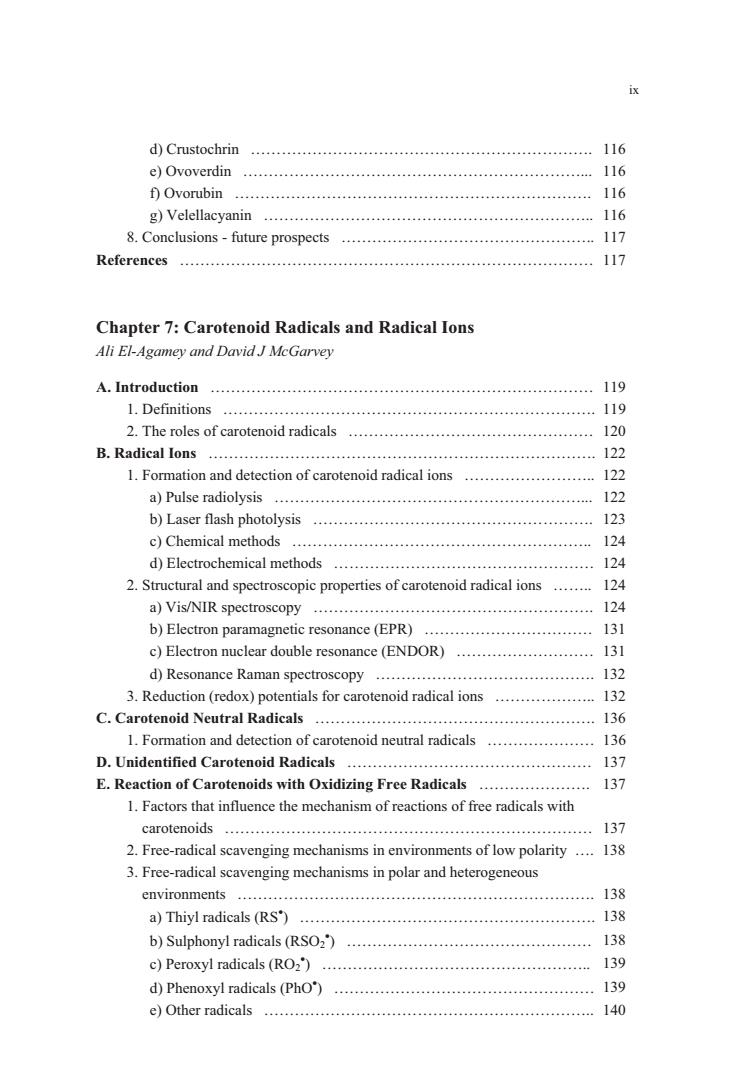正在加载图片...

ix d Crustochrin… 116 e)Ovoverdin 116 f)Ovorubin 116 g)Velellacyanin 116 8.Conclusions-future prospects 117 References 117 Chapter 7:Carotenoid Radicals and Radical Ions Ali El-Agamey and David J McGarvey A.Introduction 119 1.Definitions 119 2.The roles of carotenoid radicals 120 B.Radical Ions 122 1.Formation and detection of carotenoid radical ions .............. 122 a)Pulse radiolysis 122 b)Laser flash photolysis 123 c)Chemical methods 124 d)Electrochemical methods 124 2.Structural and spectroscopic properties of carotenoid radical ions 124 a)Vis/NIR spectroscopy 124 b)Electron paramagnetic resonance (EPR)......... 131 c)Electron nuclear double resonance(ENDOR) 131 d)Resonance Raman spectroscopy.................... 132 3.Reduction(redox)potentials for carotenoid radical ions 132 C.Carotenoid Neutral Radicals 136 1.Formation and detection of carotenoid neutral radicals 136 D.Unidentified Carotenoid Radicals 137 E.Reaction of Carotenoids with Oxidizing Free Radicals ............... 137 1.Factors that influence the mechanism of reactions of free radicals with carotenoids............... 137 2.Free-radical scavenging mechanisms in environments of low polarity .138 3.Free-radical scavenging mechanisms in polar and heterogeneous environments .138 a)Thiyl radicals(RS) 138 b)Sulphonyl radicals(RSO2) 138 c)Peroxyl radicals (RO).......................................... 139 d)Phenoxyl radicals(PhO) 139 e)Other radicals .................................................................... .140ix d) Crustochrin …………………………………………………………. 116 e) Ovoverdin …………………………………………………………... 116 f) Ovorubin ……………………………………………………………. 116 g) Velellacyanin ……………………………………………………….. 116 8. Conclusions - future prospects ………………………………………….. 117 References ……………………………………………………………………… 117 Chapter 7: Carotenoid Radicals and Radical Ions Ali El-Agamey and David J McGarvey A. Introduction ………………………………………………………………… 119 1. Definitions ………………………………………………………………. 119 2. The roles of carotenoid radicals ………………………………………… 120 B. Radical Ions …………………………………………………………………. 122 1. Formation and detection of carotenoid radical ions …………………….. 122 a) Pulse radiolysis ……………………………………………………... 122 b) Laser flash photolysis ………………………………………………. 123 c) Chemical methods ………………………………………………….. 124 d) Electrochemical methods …………………………………………… 124 2. Structural and spectroscopic properties of carotenoid radical ions …….. 124 a) Vis/NIR spectroscopy ………………………………………………. 124 b) Electron paramagnetic resonance (EPR) …………………………… 131 c) Electron nuclear double resonance (ENDOR) ……………………… 131 d) Resonance Raman spectroscopy ……………………………………. 132 3. Reduction (redox) potentials for carotenoid radical ions ……………….. 132 C. Carotenoid Neutral Radicals ………………………………………………. 136 1. Formation and detection of carotenoid neutral radicals ………………… 136 D. Unidentified Carotenoid Radicals ………………………………………… 137 E. Reaction of Carotenoids with Oxidizing Free Radicals …………………. 137 1. Factors that influence the mechanism of reactions of free radicals with carotenoids ……………………………………………………………… 137 2. Free-radical scavenging mechanisms in environments of low polarity …. 138 3. Free-radical scavenging mechanisms in polar and heterogeneous environments ……………………………………………………………. 138 a) Thiyl radicals (RS ) …………………………………………………. 138 b) Sulphonyl radicals (RSO2 ) ………………………………………… 138 c) Peroxyl radicals (RO2 ) …………………………………………….. 139 d) Phenoxyl radicals (PhO ) …………………………………………… 139 e) Other radicals ……………………………………………………….. 140